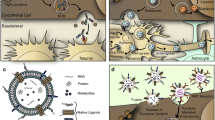Abstract
Purpose. Peptide drug delivery to the brain requires optimization of (a) plasma pharmacokinetics and (b) blood-brain barrier (BBB) permeability. In the present studies, plasma pharmacokinetics are improved with protein pegylation and BBB transport is facilitated with the use of vector-mediated drug delivery using the OX26 monoclonal antibody (MAb) to the rat transferrin receptor, which undergoes receptor-mediated transcytosis through the BBB in vivo.
Methods. A conjugate of OX26 and streptavidin (SA), designated OX26/SA, was prepared in parallel with the carboxyl-directed pegylation of brain-derived neurotrophic factor (BDNF). A novel bifunctional polyethyleneglycol (PEG) was used in which a hydrazide (Hz) was attached at one end and a biotin moiety was attached to the other end. This allowed for conjugation of BDNF-PEG-biotin to OX26/SA.
Results. The brain uptake of BDNF-PEG-biotin was increased following conjugation to OX26/SA to a level of 0.144 ± 0.004% injected dose per g brain and a BBB permeability-surface area product of 2.0 ± 0.2 μL/min/g.
Conclusions. These studies demonstrate that peptide drug delivery to the brain can be achieved with advanced formulation of protein-based therapeutics. The formulation is intended to (a) minimize rapid systemic clearance of the peptide, and (b) allow for vector-mediated drug delivery through the BBB in vivo. Following this dual formulation, the brain uptake of a neurotrophin such as BDNF achieves a value that is approximately 2-fold greater than that of morphine, a neuroactive small molecule.
Similar content being viewed by others
REFERENCES
M. B. Spina, S. P. Squinto, J. Miller, R. M. Lindsay, and C. Hyman. Brain-derived neurotrophic factor protects dopamine neurons against 6-hydroxydopamine and n-methyl-4-phenylpyridinium ion toxicity-involvement of the glutathione system. J. Neurochem. 59:99–106 (1992).
F. Hefti. Pharmacology of neurotrophic factors. Annu. Rev. Pharmacol. Toxicol. 37:239–267 (1997).
W. M. Pardridge, W.-S. Kang, and J. L. Buciak. Transport of human recombinant brain-derived neurotrophic factor (BDNF) through the rat blood-brain barrier in vivo using vector-mediated peptide drug delivery. Pharm. Res. 11:738–746 (1994).
T. Sakane and W. M. Pardridge. Carboxyl-directed pegylation of brain-derived neurotrophic factor markedly reduces systemic clearance with minimal loss of biologic activity. Pharm. Res. 14:1085–1091 (1997).
W. M. Pardridge. Drug delivery to the brain. J. Cereb. Blood Flow Metabol. 17:713–731 (1997).
W. A. Jefferies, M. R. Brandon, S. V. Hunt, A. F. Williams, K. C. Gatter, and D. Y. Mason. Transferrin receptor on endothelium of brain capillaries. Nature. 312:162–163 (1984).
W. M. Pardridge, J. Eisenberg, and J. Yang. Human blood-brain barrier transferrin receptor. Metabolism. 36:892–895 (1987).
W. M. Pardridge, J. L. Buciak, and P. M. Friden. Selective transport of anti-transferrin receptor antibody through the blood-brain barrier in vivo. J. Pharmacol. Exp. Ther. 259:66–70 (1991).
U. Bickel, Y.-S. Kang, T. Yoshikawa, and W. M. Pardridge. In vivo demonstration of subcellular localization of anti-transferrin receptor monoclonal antibody-colloidal gold conjugate within brain capillary endothelium. J. Histochem. Cytochem. 42:1493–1497 (1994).
S. Skarlatos, T. Yoshikawa, and W. M. Pardridge. Transport of [125I]-transferrin through the rat blood-brain barrier in vivo. Brain Res. 683:164–171 (1995).
M. B. Rosenberg, E. Hawrot, and X. O. Breakefield. Receptor binding activities of biotinylated derivatives of β-nerve growth factor. J. Neurochem., 46:641–648 (1986).
W. M. Pardridge. Vector-mediated peptide drug delivery to the brain. Adv. Drug Del. Rev. 15:109–146 (1995).
L. O. Narhi, R. Rosenfeld, J. Talvenheimo, S. J. Prestrelski, T. Arakawa, J. W. Lary, C. G. Kolvenbach, R. Hecht, et al. Comparison of the biophysical characteristics of human brain-derived neurotrophic factor, neurotrophin-3, and nerve growth factor. J. Biol. Chem. 268:13309–13317 (1993).
T. Arakawa, M. Haniu, L. O. Narhi, J. A. Miller, J. Talvenheimo, J. S. Philo, H. T. Chute, C. Matheson, et al. Formation of heterodimers from three neurotrophins, nerve growth factor, neurotrophin-3, and brain-derived neurotrophic factor. J. Biol. Chem. 269:27833–27839 (1994).
N. M. Green. Avidin. Adv. Prot. Chem. 29:85–133 (1975).
D. J. Glass, S. H. Nye, P. Hantzopoulos, M. J. Macchi, S. P. Squinto, M. Goldfarb, and G. D. Yancopoulos. TRKB mediates BDNF/NT-3-dependent survival and proliferation in fibroblasts lacking the low affinity NGF receptor. Cell. 66:405–413 (1991).
B. Honig and A. Nicholls. Classical electrostatics in biology and chemistry. Science 268:1144–1149 (1995).
C. F. Ibáñez, T. Ebendal, G. Barbany, J. Murray-Rust, T. L. Blundell, and H. Persson. Disruption of the low affinity receptor-binding site in NGF allows neuronal survival and differentiation by binding to the TRK gene product. Cell 69:329–341 (1992).
J. Huwyler, D. Wu, W. M. Pardridge. Brain drug delivery of small molecules using immunoliposomes. Proc Natl. and Acad Sci U.S.A. 93:14164–14169 (1996).
D. Wu, Y.-S. Kang, U. Bickel, and W. M. Pardridge. Blood-brain barrier permeability to morphine-6-glucuronide is markedly reduced compared to morphine. Drug Metab. Disp. 25:768–771 (1997).
U. Bickel, T. Yoshikawa, and W. M. Pardridge. Delivery of peptides and proteins through the blood-brain barrier. Adv. Drug Del. Rev. 10:205–245 (1993).
Author information
Authors and Affiliations
Rights and permissions
About this article
Cite this article
Pardridge, W.M., Wu, D. & Sakane, T. Combined Use of Carboxyl-Directed Protein Pegylation and Vector-Mediated Blood-Brain Barrier Drug Delivery System Optimizes Brain Uptake of Brain-Derived Neurotrophic Factor Following Intravenous Administration. Pharm Res 15, 576–582 (1998). https://doi.org/10.1023/A:1011981927620
Issue Date:
DOI: https://doi.org/10.1023/A:1011981927620




